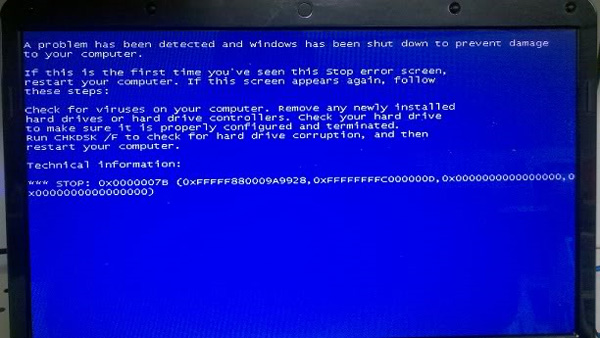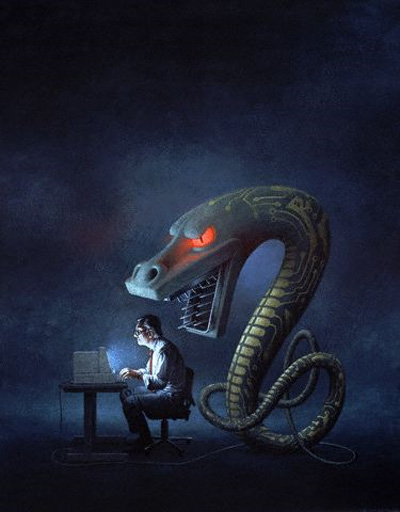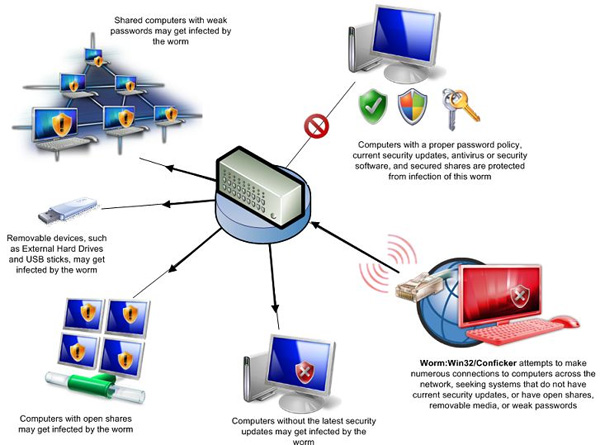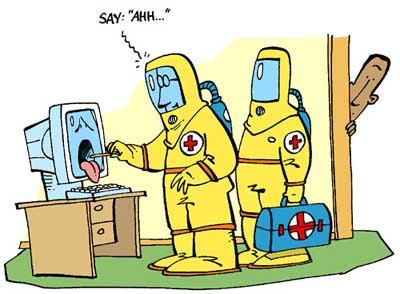Top 5 most dangerous viruses in the last 5 years
QuanTriMang - Virus - one of the most frequently encountered dangers for computer users, we may still be living and working daily with them without knowing it. For technical and security experts, they are easy to identify and prevent, but most of the rest users often find it difficult to know what the virus is, and what is the real program of the computer. In fact, viruses are software, but created with the purpose of undermining balance and security platforms in any computer system, they often cause abnormal phenomena such as increased performance. CPU's up to 100%, self-propagating, cloning and copying to directories and disk partitions . And since it began to appear, they have caused tremendous damage, consuming a lot people's money and effort in destroying and overcoming consequences. And below is a list of the 5 most dangerous viruses that have been reported over the past 5 years.
1. Alureon (2010):
Let's start with the 'title' virus of 2010 - Alureon, extremely sophisticated and cunning in stealing user login names, passwords and data in credit cards by blocking data streams via the network. Besides, they also directly affect Microsoft's Windows operating system by creating a blue screen - BSoD (Blue Screen of Death) .

2. Daprosy Worm (2009):
The worm was discovered in 2009, and was named Daprosy Worm by Symantec, a security firm. This is a type of malicious code that spreads through the LAN model, distributing spam via email and USB storage devices. Usually their original files are read1st.exe, then continue to spread, duplicate and rename them according to the archives. The most recognizable symptom is the appearance of Classified.exe files or Do not open - secrets! .Exe in the attached folder. They are 'famous' because of their ability to cripple the system, break the stability of programs operating in the operating system and constantly cause many other errors.

3. Conficker (2008):
Also known as Downup, Downadup, Kido , their attack target is Microsoft Windows operating system. Beginning to be vigorous and discovered in 2008, their attack process consisted of two main stages: first, security vulnerability MS08-067 in Server Service to allow execution of remote commands This step allows hackers to run binary code on the victim's computer without having to verify the account, and also have full control of the system. Next, the Conficker worm uses these computers to break admin account passwords in the local network, thereby easily spreading to the next computers. You can imagine their terrible devastation as millions of personal, business and government computers were affected only in 2008 across 200 countries worldwide, total losses. It was estimated at about 9.1 billion USD, mainly in Asia, South America and Europe. After "beating up" the victims, imagine that from a normal worm, they have "evolved" into Anaconda - a giant reptile monster.
It seemed like everything was over but really, Conficker came back a little while later and many more dangerous features:
- Disable DNS lookups.
- Prevent Auto Update feature.
- 'Clearing' security programs.
- Review, and interrupt the operation of processes with the names of security applications, patches, security updates or other utilities.

4. Storm Worm (2007):
Or also called Small.dam, Trojan.Peacomm, Trojan.Peed, Trojan.Tibs, W32 / Zhelatin . This can be considered the king of viruses in 2007 - Storm Worm , often attached to itself. in emails with the title 230 dead as storm batters Europe, and immediately spread it to the curious user 's computer and open the email, then continue to replicate and spread through the victims themselves.

5. Nyxem (2006):
Also known by some other names such as: Mywife, Hunchi, I-Worm.Yyem, Blackmal, Blueworm, Blackworm . First appeared in March 2006, Nyxem mainly works and spreads. via email using SMTP protocol. The worm can replicate and send e-mails to victims via different titles, content and attachments, and replicate and spread to all partitions on the hard drive. . The most dangerous part of Nyxem is the ability to remove security programs, if installed on the same location specified in the source code, or delete components in the Windows Registry, so antivirus applications Do not start automatically with the system. Besides, it also comes with a GIF file used to make the recipient think that this email has been censored and safe by Norton Anti-Virus , but in fact it is not.

You should read it
- What is Microsoft Lists? how does it use?
- Instructions on how to create drop down lists or drop-down lists in Excel
- Steps to clear Jump Lists history on Windows 10
- How to list conditional lists in Excel
- Microsoft lists many security and privacy features, Teams users should keep in mind
- How to Alphabetize in Microsoft Word
- Should a 'good' virus be developed for security purposes?
- Microsoft Listas - Online 'Handbook' of Wiki format
May be interested
- Top 10 most dangerous viruses in June 2006
 security firm sophos has just released a list of the top 10 most dangerous viruses in june 2006. accordingly, the nestky-p virus continues to dominate the first place in this list.
security firm sophos has just released a list of the top 10 most dangerous viruses in june 2006. accordingly, the nestky-p virus continues to dominate the first place in this list. - Introduction to viruses, worms, and Trojans
 viruses, worms, and trojans are dangerous programs that can destroy your computer and information on your computer, slow down the internet, and use your computer to distribute them themselves.
viruses, worms, and trojans are dangerous programs that can destroy your computer and information on your computer, slow down the internet, and use your computer to distribute them themselves. - Scan and delete dangerous viruses
 everyday, we only hear about a new and dangerous virus spreading on the internet, infecting millions of windows computers ...
everyday, we only hear about a new and dangerous virus spreading on the internet, infecting millions of windows computers ... - Mobile device viruses increase 10 times faster than on PC
 dangerous programs in the coming years will cause great damage to mobile devices because very few people using this type of product install system protection software.
dangerous programs in the coming years will cause great damage to mobile devices because very few people using this type of product install system protection software. - 2005: viruses focus on quality over quantity
 2005 will probably be a happy year for computer users around the globe because this is the year when 'online life' seems safe because the number of dangerous computer viruses released has decreased by one. c &
2005 will probably be a happy year for computer users around the globe because this is the year when 'online life' seems safe because the number of dangerous computer viruses released has decreased by one. c & - Top 5 DANGEROUS VIRUS types that you need to be wary of in 2021
 warning you about 5 new extremely dangerous viruses that you need to be vigilant about to avoid losing data as well as online accounts, bank accounts ..
warning you about 5 new extremely dangerous viruses that you need to be vigilant about to avoid losing data as well as online accounts, bank accounts .. - Why is a virus scanning program not enough?
 on the market today, no independent virus scanner is rated as the fastest or most effective in identifying viruses, trojans and other dangerous threats. this article will specify the reason for s
on the market today, no independent virus scanner is rated as the fastest or most effective in identifying viruses, trojans and other dangerous threats. this article will specify the reason for s - 2005 signaled the decline of computer viruses
 hackers this year seem to be indifferent to viruses, but other dangerous programs are rampant and make users' pc systems more vulnerable than ever.
hackers this year seem to be indifferent to viruses, but other dangerous programs are rampant and make users' pc systems more vulnerable than ever. - 2 viruses that destroy data
 the following 2 computer worms belong to cyclical, dispersal operations on a fixed day every month. they are extremely dangerous because when the data is destroyed by these two viruses, it cannot be recovered.
the following 2 computer worms belong to cyclical, dispersal operations on a fixed day every month. they are extremely dangerous because when the data is destroyed by these two viruses, it cannot be recovered. - Use the CMD command to remove viruses on Windows computers
 once the computer is compromised, the virus can cause a variety of problems such as slowing down the computer operating system, and even some viruses that can steal user data.
once the computer is compromised, the virus can cause a variety of problems such as slowing down the computer operating system, and even some viruses that can steal user data.










 Cloud computing transforms how to prevent viruses?
Cloud computing transforms how to prevent viruses? Virus appears to attack Twitter users
Virus appears to attack Twitter users Difference between Virus, Spyware and Malware
Difference between Virus, Spyware and Malware Around the world, about 50% of computers are infected with viruses
Around the world, about 50% of computers are infected with viruses Vietnam lost VND 5,900 billion because of computer viruses
Vietnam lost VND 5,900 billion because of computer viruses Smartphone was attacked by ZeuS Trojan virus
Smartphone was attacked by ZeuS Trojan virus